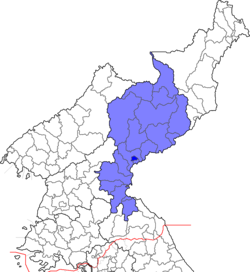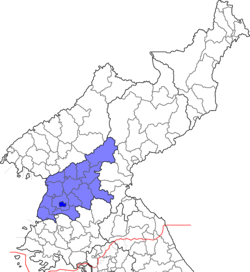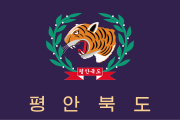Committee for the Five Northern Korean Provinces
 From Wikipedia - Reading time: 11 min
From Wikipedia - Reading time: 11 min
| 이북5도위원회 | |
 | |
 Flag | |
| Agency overview | |
|---|---|
| Type | Government body under the South Korean Ministry of the Interior and Safety |
| Jurisdiction | Government of South Korea |
| Headquarters | 64 Bibong-gil, Jongno, Seoul |
| Agency executives |
|
| Parent department | Ministry of the Interior and Safety |
| Website | www.ibuk5do.go.kr |
| Map | |
 Map of North Korea with provincial divisions claimed by South Korea | |
| Committee for the Five Northern Korean Provinces | |
| Hangul | 이북5도위원회 |
|---|---|
| Hanja | 以北五道委員會 |
| Revised Romanization | Ibuk Odo Wiwonhoe |
| McCune–Reischauer | Ibuk Odo Wiwŏnhoe |
The Committee for the Five northern Korean Provinces (Korean: 이북5도위원회; Hanja: 以北五道委員會, literally "The North's Five Provinces Committee"[note 1]) is a South Korean government body under the Ministry of the Interior and Safety.
History
[edit]Established in 1949, the committee is officially responsible for the administration of the five Korean provinces located entirely north of the 38th Parallel, also known as the Military Demarcation Line, as the South Korean government formally claims to be the sole legitimate government of the entirety of the Korean Peninsula. The South Korean government does not officially recognize any changes to the borders of the northern provinces made by the North Korean government since its establishment back in 1949. The President of South Korea appoints governors for each of the five provinces.[2] However, their role is largely symbolic (comparable to titular bishops), as the territory is under the effective jurisdiction of North Korea. The committee's main practical function is to provide support to North Korean defectors living in South Korea, including helping with the resettlement of North Koreans and organizing social events for North Koreans.[2][3]
Despite its name, the committee plays no part in North Korea–South Korea relations; North Korean affairs are handled by the Ministry of Unification.[2] In the event of a North Korean collapse, contingency plans call for a new government body to be set up to administer the North under the leadership of the Unification Minister. In that case, the five governors would have to resign and the committee would be disbanded.[2][4]
North Hamgyeong
[edit]North Hamgyeong Province | |
|---|---|
| Korean transcription(s) | |
| • Hangul | 함경북도 |
| • Hanja | 咸鏡北道 |
| • Revised Romanization | Hamgyeongbuk-do |
 | |
| Capital | Cheongjin |
| Subdivisions | 3 cities; 11 counties |
| Government | |
| • Governor | Ji Seong-ho |
| Area | |
• Total | 20,345 km2 (7,855 sq mi) |
North Hamgyeong Province or Hamgyeongbuk-do (Korean pronunciation: [hamɡjʌŋbukt͈o]) corresponds to North Korea's North Hamgyong Province, Rason Special City and part of Ryanggang Province.
Hamgyeongbuk-do is divided into 3 cities (si) and 11 counties (gun):
Cities:
Counties:
- Gyeongseong (경성, 鏡城) (administrative center at Gyeongseong-myeon)
- Myeongcheon (명천, 明川) (administrative center at Sangwubuk-myeon)
- 10 myeon : Sangwubuk, Dong, Sangga, Sanggo, Sangwunam, Seo, Agan, Haga, Hago, Hawu
- Gilju (길주, 吉州)
- 1 eup : Gilju
- 5 myeon : Deoksan, Donghae, Yangsa, Ungpyeong, Jangbaek
- Hakseong (학성, 鶴城) (administrative center at Seongjin)
- 5 myeon : Hakseo, Hakdong, Hakjung, Haknam, Haksang
- Buryeong (부령, 富寧)
- 8 myeon : Buryeong, Gwanhae, Bugeo, Samhae, Seosang, Seokmak, Yeoncheon, Cheongam
- Musan (무산, 茂山)
- 1 eup : Musan
- 9 myeon : Dong, Samjang, Samsa, Seoha, Eoha, Yeonsa, Yeonsang, Yeongbuk, Punggye
- Hoenyeong (회녕, 會寧)
- 1 eup : Hoenyeong
- 6 myeon : Byeokseong, Boeul, Yongheung, Changdu, Paleul, Hwapyeong
- Jongseong (종성, 鍾城)
- 6 myeon : Jongseong, Namsan, Yonggye, Punggok, Haengyeong, Hwabang
- Onseong (온성, 穩城)
- 6 myeon : Onseong, Namyang, Mipo, Yeongwa, Yeongchung, Hunyung
- Gyeongwon (경원, 慶源)
- 6 myeon : Gyeongwon, Dongwon, Asan, Annong, Yongdeok, Yudeok
- Gyeongheung (경흥, 慶興) (administrative center at Unggi-eup)
- 2 eup : Unggi, Aoji
- 3 myeon : Gyeonghung, Punghae, Noseo
South Hamgyeong
[edit]South Hamgyeong Province | |
|---|---|
| Korean transcription(s) | |
| • Hangul | 함경남도 |
| • Hanja | 咸鏡南道 |
| • Revised Romanization | Hamgyeongnam-do |
 | |
| Capital | Hamheung |
| Subdivisions | 3 cities; 16 counties |
| Government | |
| • Governor | Son Yang-young |
| Area | |
• Total | 31,977 km2 (12,346 sq mi) |
South Hamgyeong Province (Korean: 함경남도, Hamgyeongnam-do) (Korean pronunciation: [hamɡjʌŋnamdo]) corresponds to North Korea's South Hamgyong Province, as well as parts of Ryanggang Province, Chagang Province, Kangwon Province and China's Jilin Province (several parts of Hyesan County (Heaven Lake) are under the rule of China, and other parts of same county are claimed by the Republic of China).
Hamgyeongnam-do is divided into 3 cities (si) and 16 counties (gun):
Cities:
Counties:
- Hamju (함주, 咸州) (administrative center at Hamheung)
- 16 myeon : Gigok, Deoksan, Dongcheon, Sampyeong, Sanggicheon, Sangjoyang, Seondeok, Yeonpo, Jubuk, Juseo, Juji, Cheonseo, Cheonwon, Toejo, Hagicheon, Hajoyang
- Sinheung (신흥, 新興)
- 8 myeon : Sinheung, Gapyeong, Sangwoncheon, Seogocheon, Yeonggo, Wonpyeong, Hawoncheon, Dongsang
- Jeongpyeong (정평, 定平)
- 8 myeon : Chongpyong, Gosan, Gwangdeok, Gwirim, Munsan, Sinsang, Jangwon, Jui
- Yeongheung (영흥, 永興)
- 1 eup : Yeongheung
- 11 myeon : Goryeong, Deokheung, Seonheung, Sunryeong, Eokgi, Yodeok, Inheung, Jangheung, Jinpyeong, Hodo, Heongcheon
- Gowon (고원, 高原)
- 1 eup : Gowon
- 5 myeon : Gunnae, Sangok, Sangsan, Sudong, Ungok
- Muncheon (문천, 文川) (administrative center at Muncheon-myeon)
- 1 eup : Cheonnae
- 7 myeon : Muncheon, Deokwon, Myeonggu, Bukseong, Unrim, Pungsang, Pungha
- Anbyeon (안변, 安邊)
- 7 myeon : Anbyeon, Ando, Seokwangsa, Baehwa, Seogok, Singosan, Sinmo
- Hongwon (홍원, 洪原)
- 1 eup : Hongwon
- 6 myeon : Gyeongwun, Bohyeon, Samho, Yongwon, Yongpo, Unhak
- Bukcheong (북청, 北靑)
- 3 eup : Bukcheong, Sinpo, Sinchang
- 11 myeon : Gahoe, Geosan, Deokseong, Sanggeoseo, Seongdae, Sokhu, Sin-Bukcheong, Yanghwa, Igok, Hageoseo, Huchang
- Iwon (이원, 利原) (administrative center at Iwon-myeon)
- 1 eup : Chaho
- 3 myeon : Iwon, Dong, Namsong
- Dancheon (단천, 端川)
- 1 eup : Dancheon
- 8 myeon : Gwangcheon, Damduil, Bokgwi, Bukdoil, Suha, Sinman, Ijung, Hada
- Jangjin (장진, 長津)
- 7 myeon : Jangjin, Dongmun, Dongha, Buk, Sangnam, Seohan, Jungnam
- Pungsan (풍산, 豐山)
- 5 myeon : Pungsan, Ansan, Ansu, Ungyi, Cheonnam
- Samsu (삼수, 三水)
- 7 myeon : Samsu, Geumsu, Gwanheung, Samseo, Sinpa, Jaseo, Hoin
- Gapsan (갑산, 甲山)
- 5 myeon : Gapsan, Dongin, Jindong, Sannam, Hoerin
- Hyesan (혜산, 惠山)
- 1 eup : Hyesan
- 5 myeon : Daejin, Byeoldong, Bocheon, Bongdu, Unheung
Hwanghae
[edit]Hwanghae Province | |
|---|---|
| Korean transcription(s) | |
| • Hangul | 황해도 |
| • Hanja | 黃海道 |
| • Revised Romanization | Hwanghae-do |
 | |
| Capital | Haeju |
| Subdivisions | 3 cities; 17 counties |
| Government | |
| • Governor | Kee Duck-young |
| Area | |
• Total | 16,743.66 km2 (6,464.76 sq mi) |
Hwanghae Province or Hwanghae-do (Korean pronunciation: [hwaŋ.hɛ.do]) corresponds to North Korea's North Hwanghae Province (except Kaesong which is claimed to be part of Gyeonggi Province) and South Hwanghae Province.
Hwanghae-do is divided into 3 cities (si) and 17 counties (gun):
Cities:
Counties:
- Byeokseong (벽성; 碧城) (administrative center at Haeju)
- 20 myeon : Gajwa, Geomdan, Gosan, Nadeok, Daegeo, Donggang, Miyul, Seoseok, Songrim, Unsan, Wolrok, Janggok, Haenam, Geumsan, Naesong, Dongun, Yeongcheon, Ilsin, Cheongryong, Chuhwa
- Yeonbaek (연백; 延白)
- 1 eup : Yeonan
- 19 myeon : Gwaegung, Geumsan, Dochon, Mokdan, Bongbuk, Bongseo, Seoksan, Songbong, Onjeong, Yongdo, Unsan, Yugok, Euncheon, Haeryong, Haeseong, Haewol, Honam, Hodong, Hwaseong
- Ongjin (옹진; 甕津)
- 1 eup : Ongjin
- 10 myeon : Gacheon, Gyojeong, Dongnam, Bonggu, Bumin, Buk, Seo, Yongyeon, Yongcheon, Heungmi
- Jangyeon (장연; 長淵)
- 1 eup : Jangyeon
- 9 myeon : Nakdo, Daegu, Mokgam, Sokdal, Suntaek, Sinhwa, Yongyeon, Haean, Hunam
- Geumcheon (금천; 金川)
- 12 Myeon : Geumcheon, Godong, Gui, Sanoe, Seobuk, Seocheon, Oeryu, Ubong, Ungdeok, Jwa, Tosan, Habtan
- Singye (신계; 新溪)
- 8 myeon : Singye, Go, Dami, Dayul, Maseo, Saji, Jeokyeo, Chon
- Pyeongsan (평산; 平山)
- 1 eup : Namcheon
- 13 myeon : Pyongsan, Goji, Geumam, Masan, Munmu, Sangwol, Seobong, Segok, Sinam, Anseong, Yongsan, Insan, Jeokam
- Bongsan (봉산; 鳳山) (administrative center at Sariwon)
- 13 myeon : Guyeon, Gicheon, Deokjae, Dongseon, Mancheon, Munjeong, Sain, Sansu, Seojeong, Ssangsan, Yeongcheon, Chowa, Toseong
- Seoheung (서흥; 瑞興)
- 1 eup : Sinmak
- 10 myeon : Seoheung, Gupo, Naedeok, Do, Maeyang, Mokgam, Sepyeong, Sosa, Yongpyeong, Yulri
- Jaeryeong (재령; 載寧)
- 1 eup : Jaeryeong
- 10 myeon : Namryul, Bukryul, Samgang, Sangseong, Seoho, Sinwon, Eunryong, Jangsu, Cheongcheon, Haseong
- Sincheon (신천; 信川)
- 1 eup : Sincheon
- 14 myeon : Garyeon, Gasan, Gungheung, Nambu, Nowol, Dura, Munmu, Munhwa, Bukbu, Sancheon, Oncheon, Yongmun, Yongjin, Chori
- Songhwa (송화; 松禾)
- 13 myeon : Songhwa, Punghae, Dowon, Bongrae, Sangri, Yeonbang, Yeonjeong, Unyu, Yulri, Jangyang, Jinpung, Cheondong
- Eunyul (은율; 殷栗)
- 7 myeon : Eunyul, Nambu, Bukbu, Seobu, Ildo, Ido, Jangryeon
- Anak (안악; 安岳)
- 1 eup : Anak
- 8 myeon : Daewon, Daehaeng, Munsan, Seoha, Angok, Yongmun, Yongsun, Eunhong
- Hwangju (황주; 黃州)
- 1 eup : Hwangju
- 11 myeon : Gurak, Guseong, Dochi, Samjeon, Yeongpung, Ingyo, Junam, Cheonju, Cheongryong, Cheongsu, Heukgyo
- Suan (수안; 遂安)
- 9 myeon : Suan, Gongpo, Daeseong, Daeo, Doso, Sugu, Yeonam, Yulgye, Cheongok
- Goksan (곡산; 谷山)
- 12 myeon : Goksan, Dohwa, Dongchon, Myeokmi, Bongmyeong, Sangdo, Seochon, Unjung, Iryeong, Cheonggye, Hado, Hwachon
North Pyeongan
[edit]North Pyeongan Province | |
|---|---|
| Korean transcription(s) | |
| • Hangul | 평안북도 |
| • Hanja | 平安北道 |
| • Revised Romanization | Pyeonganbuk-do |
 | |
| Capital | Sinuiju |
| Subdivisions | 1 cities; 19 counties |
| Government | |
| • Governor | Yi Se-oong |
| Area | |
• Total | 28,442.9 km2 (10,981.9 sq mi) |
North Pyeongan Province or Pyeonganbuk-do (Korean pronunciation: [pʰjʌŋanbukt͈o]) corresponds to North Korea's North Pyongan Province, almost all of Chagang Province and a small part of Ryanggang Province.
Pyeonganbuk-do is divided into 1 cities (si) and 19 counties (gun):
Cities:
Counties:
- Euiju (Korean: 의주; Hanja: 義州)
- Yongcheon (용천, 龍川)
- 1 eup : Yongampo
- 11 myeon : Dongha, Naejung, Dongsang, Bura, Bukjung, Yangseo, Yanggwang, Yangha, Oesang, Oeha, Sindo
- Cheolsan (철산, 鐵山)
- 6 myeon : Cheolsan, Baekryang, Buseo, Cham, Seorim, Yeohan
- Seoncheon (선천, 宣川)
- 1 eup : Seoncheon
- 8 myeon : Gunsan, Nam, Unjong, Dong, Sucheong, Sinbu, Simcheon, Yongyeon, Taesan
- Jeongju (정주, 定州)
- 1 eup : Jeongju
- 12 myeon : Galsan, Godeok, Goan, Gwaksan, Gwanju, Namseo, Daejeon, Deokeon, Masan, Anheung, Okcheon, Impo
- Sakju (삭주, 朔州) (administrative center at Sakju-myeon)
- 1 eup : Cheongsu
- 7 myeon : Sakju, Gugok, Namseo, Sudong, Supung, Oenam, Yangsan
- Guseong (구성, 龜城)
- 10 myeon : Guseong, Gwanseo, Nodong, Dongsan, Banghyeon, Sagi, Seosan, Obong, Ihyeon, Cheonma
- Yeongbyeon (영변, 寧邊)
- 14 myeon : Yeongbyeon, Goseong, Namsong, Namsinhyeon, Doksan, Baekryeong, Bongsan, Buksinhyeon, Sorim, Yeonsan, Ori, Yongsan, Taepyeong, Palwon
- Bakcheon (박천, 博川)
- 1 eup : Bakcheon
- 7 myeon : Gasan, Deokan, Dongnam, Seo, Yangga, Yonggye, Cheongryong
- Taecheon (태천, 泰川)
- 9 myeon : Taecheon, Gangdong, Gangseo, Nam, Dong, Seo, Seoseong, Won, Jangrim
- Unsan (운산, 雲山) (administrative center at Unsan-myeon)
- 1 eup : Bukjin
- 4 myeon : Unsan, Dongsin, Seong, Wiyeon
- Changseong (창성, 昌城)
- 5 myeon : Changseong, Daechang, Dongchang, Sinchang, Cheongsan
- Byeokdong (벽동, 碧潼)
- 7 myeon : Byeokdong, Gabyeol, Gwonhoe, Seongnam, Songseo, Obuk, Usi
- Chosan (초산, 楚山)
- 9 myeon : Chosan, Gang, Go, Nam, Dowon, Dong, Song, Pan, Pung
- Wiwon (위원, 渭原)
- 7 myeon : Wiwon, Daedeok, Seotae, Bongsan, Sungjeong, Wisong, Hwachang
- Heuicheon (희천, 熙川)
- 1 eup : Heuicheon
- 7 myeon : Nam, Dong, Dongchang, Buk, Seo, Sinpung, Jangdong, Jin
- Ganggye (강계, 江界)
- 2 eup : Ganggye, Manpo
- 15 myeon : Ganbuk, Gosan, Gokha, Gongbuk, Seonggan, Sijung, Eoroe, Oegwi, Yongrim, Iseo, Ipgwan, Jeoncheon, Jongnam, Jongseo, Hwagyeong
- Jaseong (자성, 慈城)
- 6 myeon : Jaseong, Sampung, Ipyeong, Jaha, Jangto, Junggang
- Huchang (후창, 厚昌)
- 5 myeon : Huchang, Namsin, Dongheung, Dongsin, Chilpyeong
List of historic governors
[edit]- Baek Yeong-eop (백영업, 白永燁; 1949–1970)
- Lee Ha-young (이하영, 李夏榮, 1970–1979)
- Lee Seok-bong (이석봉, 李碩峰; 1979 – May 1988)
- Ahn Chi-soon (안치순, 安致淳; May – December 1988)
- Kim Sa-seong (김사성, 金士檉; 1989 – March 1992)
- Jang Jung-ryol (장정렬, 張正烈; 1992–1998)
- Shim Gi-cheol (심기철, 沈基哲; 1998–2000)
- Paik Hyong-rin (백형린, 白亨麟; 2000–2003)
- Cha In-tae (차인태, 車仁泰; 2003–2007)
- Paik Do-woong (백도웅, 白道雄; 2007–2009)
- Paik Young-chul (백영철, 白永哲; 2009–2012)
- Paik Gu-seop (백구섭, 白九燮;(2012–2016)
- Kim Young-chol (김영철, 金永哲; 2016–2019)
- Oh Yeong-chan (오영찬, 吳永瓚; 2019 – July 2022)
- Yi Se-oong (이세웅; July 2022 – present)
South Pyeongan
[edit]South Pyeongan Province | |
|---|---|
| Korean transcription(s) | |
| • Hangul | 평안남도 |
| • Hanja | 平安南道 |
| • Revised Romanization | Pyeongannam-do |
 | |
| Country | Republic of Korea (claimed) |
| Capital | Pyeongyang |
| Subdivisions | 2 cities; 14 counties |
| Government | |
| • Governor | Jeong Jyeong-jo |
| Area | |
• Total | 14,944 km2 (5,770 sq mi) |
South Pyeongan Province or Pyeongannam-do (Korean pronunciation: [pʰjʌŋannamdo]) corresponds to North Korea's South Pyongan Province, Pyongyang Directly Governed City and Nampo Special City.
Pyeongannam-do is divided into 2 cities (si) and 14 counties (gun):
Cities:
- Pyeongyang (평양; 平壤)
- 91 dong
- Jinnampo (진남포, 鎭南浦)
- 11 dong
Counties:
- Daedong (대동, 大同) (administrative center at Pyongyang)
- 14 myeon : Gopyeong, Yongsan, Gimje, Daebo, Namhyeongjesan, Jaegyeongri, Yongak, Busan, Sijok, Imwon, Cheongryong, Yulri, Yongyeon, Namgot
- Junghwa (중화, 中和)
- 11 myeon : Junghwa, Gandong, Dangjeong, Dongdu, Sangwon, Susan, Sinheung, Yangjeong, Cheongok, Pungdong, Haeap
- Gangseo (강서, 江西)
- 14 myeon : Gangseo, Dongjin, Banseok, Borim, Seongam, Seongtae, Susan, Sinjeong, Ssangryong, Ingcha, Jeokseong, Jeungsan, Chori, Hamjong
- Gangdong (강동, 江東)
- 1 eup : Seungho
- 5 myeon : Gangdong, Gocheon, Bongjin, Samdeung, Wontan
- Yonggang (용강, 龍岡)
- 13 myeon : Yonggang, Gwiseong, Geumgok, Dami, Daedae, Samhwa, Seohwa, Sinnyeong, Ynaggok, Osin, Yongwol, Jiun, Haeun
- Suncheon (순천, 順川)
- Anju (안주, 安州)
- 1 eup : Anju
- 7 myeon : Daeni, Dong, Sin-Anju, Yeonho, Yonghwa, Ungok, Ipseok
- Pyeongwon (평원, 平原)
- 16 myeon : Pyongwon(Yeongyu), Geomsan, Gongdeok, Noji, Deoksan, Dongsong, Dongam, Seohae, Sukcheon, Sunan, Yanghwa, Yongho, Joun, Cheongsan, Hancheon, Haeso
- Gaecheon (개천, 价川)
- 1 eup : Gaecheon
- 5 myeon : Bongdong, Buk, Joyang, Jungnam, Jungseo
- Deokcheon (덕천, 德川)
- 6 myeon : Deokcheon, Seongyang, Ilha, Jamdo, Jamsang, Pungdeok
- Yeongwon (영원, 寧遠)
- 9 myeon : Yeongwon, Daehung, Deokhwa, Seongryong, Sobaek, Sinseong, Yeongrak, Onhwa, Taegeuk
- Maengsan (맹산, 孟山)
- 8 myeon : Maengsan, Dong, Bongin, Aejeon, Okcheon, Wonnam, Jideok, Hakcheon
- Yangdeok (양덕, 陽德)
- 1 eup : Yangdeok
- 6 myeon : Dongyang, Daeryun, Ssangryong, Ogang, Oncheon, Hwachon
- Seongcheon (성천, 成川)
- 12 myeon : Seongcheon, Guryong, Neungjung, Daegok, Daegu, Saga, Samdeok, Samheung, Sungin, Ssangryong, Yeongcheon, Tongseon
Southern provinces with territory in North Korea
[edit]Two South Korean provinces, Gyeonggi and Gangwon, officially have parts of their territory in North Korea. The South Korean government considers the governors of these two provinces the head of their entire province, including the parts in the North.[4]
- Gyeonggi Province – Gaeseong, Gaepung County & Jangdan County claimed
- Gangwon Province – from Kangwon province – Gimhwa County, Icheon County, Tongcheon County, Pyeonggang County and Hoeyang County claimed
Historical symbols
[edit]-
Flag of the Committee for the Five Northern Korean Provinces (1949–2016)
-
Emblem of the Committee for the Five Northern Korean Provinces (1949–2016)
-
Former flag of North Pyeongan Province (1949–2019)
See also
[edit]- Eight Provinces of Korea
- Korean reunification
- Committee for the Peaceful Reunification of the Fatherland
References
[edit]- ^ Choe, Sang-hun (9 October 2024). "In This Office, the Fading Dream of a Unified Korea Lives On". The New York Times. Retrieved 12 November 2024.
- ^ a b c d "South Korea's Governors of Northern Provinces Don't—And Never Will—Govern". The Wall Street Journal. March 17, 2014. Archived from the original on 2014-12-15. Retrieved 2 April 2014.
- ^ "Purpose/Function". The Committee for the Five Northern Korean Provinces. Archived from the original on 7 April 2014. Retrieved 2 April 2014.
- ^ a b "South Korea's Governors-in-Theory for North Korea". The Wall Street Journal. March 18, 2014. Retrieved 29 April 2014.
 KSF
KSF






